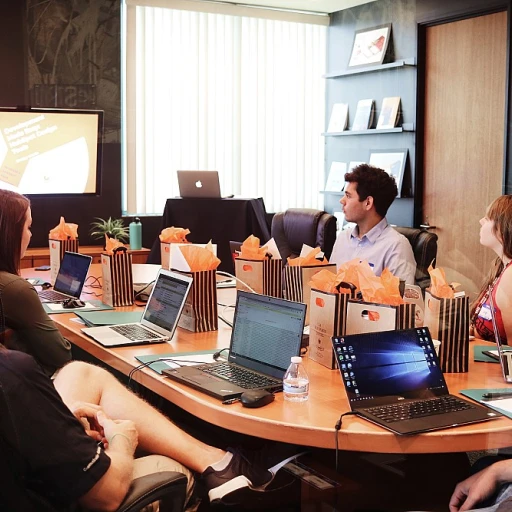
Understanding the Importance of Reskilling in Education
Recognizing the Critical Role of Reskilling in Education
The education sector is evolving rapidly, making it imperative for educators to adapt and refine their teaching strategies. In this dynamic landscape, reskilling has emerged as a fundamental aspect for maintaining effective teaching and ensuring the continuous growth of students. Whether it's integrating technology into lesson plans or exploring project based learning, educators must continuously update their skills to keep up with the changing demands.
As classroom dynamics shift and new methods emerge, the ability to engage students through innovative approaches becomes crucial. The importance of reskilling in education cannot be overemphasized, as it directly impacts student engagement and learning outcomes. Teachers who reskill are better equipped to implement active learning and differentiated instruction, catering to the diverse needs of all learners.
Moreover, reskilling helps educators stay abreast of professional development opportunities, fostering an environment conducive to critical thinking and problem solving. By prioritizing ongoing learning and adaptation, teachers can create a supportive learning environment that not only benefits the students but also enhances their own professional journey.
To learn more about sustaining a successful career through continuous skill enhancement, explore our insights on mastering essential skills.
Identifying Core Skills for Effective Teaching
Pinpointing Essential Skills for Dynamic Instruction
Identifying the core skills necessary for effective teaching involves understanding the intricate dynamics of a classroom and recognizing the evolving demands on educators. Educators are tasked with not just delivering content but fostering a nurturing environment for learners. Key skills include:- Critical Thinking and Problem Solving: This enables educators to guide students through complex learning processes, encouraging analytical thinking and real-world problem-solving skills.
- Adaptability in Teaching Methods: Successful teachers employ a variety of teaching strategies, actively engaging students with methods such as differentiated instruction and project-based learning. This adaptability equips students to thrive in diverse learning environments.
- Culturally Responsive Teaching: With classrooms becoming increasingly diverse, educators must practice culturally responsive teaching. This approach helps students feel valued and understood, promoting a more inclusive atmosphere conducive to learning.
- Enhancing skills with DEIA training can be a valuable resource in this regard, helping educators understand and apply these concepts.
- Implementation of Formative Assessments: Teachers who regularly use formative assessments are better able to gauge student progress, adapt instruction, and provide feedback that significantly bolsters the learning process.
Incorporating Technology in Teaching Methods
Leveraging Technology to Enhance Teaching Skills
Incorporating technology into teaching methods is crucial for educators aiming to boost effective teaching and facilitate engaged learning. In a world where digital platforms dominate, understanding how to blend technology with traditional strategies is essential for educators. Teachers can tap into a myriad of technological resources to design a more interactive and inclusive classroom experience. Firstly, integrating technology can aid in differentiated instruction, helping students learn at their own pace. Tools such as adaptive learning software adapt the content based on individual student understanding, ensuring every learner, whether proficient in math or struggling with reading, receives personalized attention. Interactive tools, like smartboards and educational apps, offer teachers innovative ways to maintain student engagement through interactive activities. This not only promotes active learning but also fosters essential skills like critical thinking and problem solving. Interactive platforms can transform a traditional classroom into a dynamic learning environment where students are motivated to participate and explore. Furthermore, technology empowers teachers to employ project-based learning methods effectively. Platforms that facilitate collaborative learning projects encourage students to take charge of their own learning process, enhancing their ability to work in teams and develop real-world skills. Teachers can guide students in research and encourage creative thinking through these digital mediums. For educators keen on continuously improving their teaching methods, various online platforms offer robust professional development courses. These courses focus on effective teaching strategies and culturally responsive teaching techniques, enabling teachers to better cater to diverse classroom settings. In addition, technology aids in the practice of formative assessment, allowing educators to quickly gauge student understanding and adjust their teaching strategies accordingly. By using digital platforms for assessments, teachers can provide timely feedback, thus supporting the learning process and helping students improve. To fully harness technology in the educational sphere, school leaders must advocate for and invest in the necessary infrastructure and resources. By doing so, they create a supportive learning environment where teaching strategies can evolve with the needs of students. For a deeper dive into modern strategies for improving teaching skills through technology, explore insights on enhancing workforce capabilities with modern talent management systems.Adopting Innovative Pedagogical Approaches
Embracing New Teaching Dynamics
To adopt innovative pedagogical approaches effectively, educators must first open themselves to new teaching strategies that emphasize creativity and adaptability. These strategies enhance the learning process and foster a classroom environment where critical thinking and problem solving take center stage.
Start by integrating active learning and project-based learning, which transform the traditional classroom dynamic. By doing so, educators can increase student engagement and allow learners to take charge of their own education. This active involvement enhances students' learning skills, encouraging them to apply theoretical knowledge to real-world scenarios.
- Differentiated Instruction: By tailoring teaching methods to meet the varied needs of students, teachers can provide a more inclusive learning experience that respects individual learning styles and paces.
- Service Learning: Integrating community service into the curriculum connects classroom lessons with societal applications, enhancing the educational process and fostering empathy among students.
- Culturally Responsive Teaching: Educators should implement strategies that are inclusive of students' cultural backgrounds. This approach not only improves student engagement but also prepares learners for a globalized world.
Furthermore, teaching strategies such as formative assessment allow for continuous feedback, guiding both teachers and students throughout the learning journey. This ensures that adjustments can be made to suit evolving classroom needs.
For educators looking to broaden their toolkit, utilizing available resources can be of immense help. There are numerous professional development programs and resources that focus on embedding innovative teaching techniques within the educational framework, supporting educators in delivering effective teaching solutions.
Building a Supportive Learning Environment
Creating a Nurturing Atmosphere for Optimal Learning
Building a supportive learning environment is pivotal for effective teaching. Educators are often faced with the challenge of catering to diverse student needs, ensuring that every learner feels valued and understood. A nurturing atmosphere helps students thrive, promoting active learning and enhancing the overall learning process. To cultivate such an environment, consider these strategies:- Promote Inclusivity: Ensure that the classroom is culturally responsive. Tailor your teaching methods to acknowledge and celebrate student diversity, fostering a sense of belonging.
- Encourage Open Communication: Building strong relationships with students is essential. Encourage them to voice their opinions and listen actively to their concerns. This practice not only boosts student engagement but also reinforces trust.
- Implement Differentiated Instruction: Address the varied learning styles and abilities within your class. Tailor teaching strategies to help students with different needs, ensuring each one can grasp the material effectively.
- Incorporate Formative Assessment: Continuous assessment strategies provide insights into student understanding. Use this feedback to adjust teaching methods, ensuring they align with learner capabilities and preferences.
- Foster Critical Thinking and Problem Solving: Encourage students to engage in projects and problem-based learning activities. These methods not only enhance critical skills but also make the learning experience more dynamic.
Continuous Professional Development for Educators
Embracing Lifelong Learning for Educators
In the ever-evolving landscape of education, continuous professional development is not just an option but a necessity for educators. As teaching methods and strategies evolve, so must the skills of teachers to ensure they remain effective in the classroom. This ongoing learning process is crucial for adapting to new teaching strategies and technologies that enhance student engagement and learning outcomes.
Strategies for Continuous Improvement
- Active Learning Workshops: Participating in workshops focused on active learning can help teachers develop new skills and techniques that promote critical thinking and problem-solving among students.
- Project-Based Learning: Engaging in project-based learning initiatives allows educators to experience firsthand the benefits of this approach, which can then be applied in their own classrooms to foster a more dynamic learning environment.
- Formative Assessment Techniques: Regularly updating assessment methods ensures that teachers can effectively gauge student progress and adjust their teaching strategies accordingly.
- Culturally Responsive Teaching: Understanding and implementing culturally responsive teaching methods can help educators create inclusive classrooms that respect and celebrate diversity.
Leveraging Resources for Professional Growth
Educators have access to a wealth of resources that can aid in their professional development. Online courses, webinars, and educational conferences provide opportunities to learn from experts and peers. School leaders can also play a pivotal role by supporting teachers in their pursuit of professional growth, whether through funding for courses or providing time for collaborative learning sessions.
Building a Collaborative Learning Community
Creating a supportive learning environment among educators is essential for fostering continuous improvement. By sharing best practices and learning from one another, teachers can collectively enhance their teaching skills. This collaborative approach not only benefits individual educators but also contributes to a more effective teaching community overall.
Ultimately, the commitment to continuous professional development empowers educators to adapt to new challenges and opportunities in education, ensuring they can effectively help students succeed in an ever-changing world.













